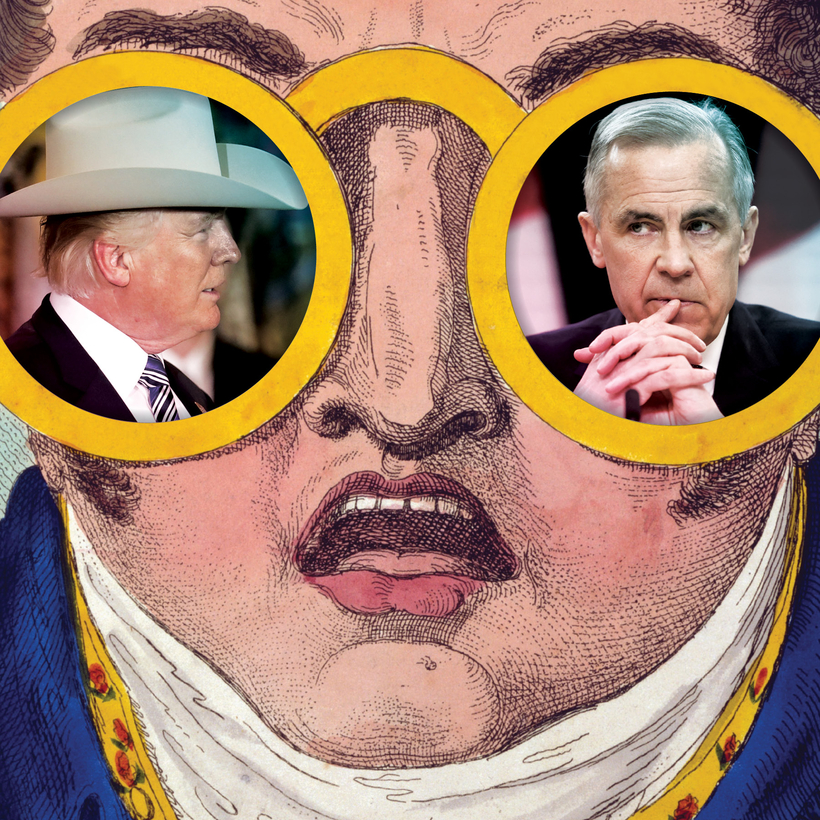On the morning of November 26, 2012, the day Bank of Canada Governor Mark Carney was appointed to head the Bank of England, The Guardian’s live blog, anticipating the event, opened with the names of five possible successors to the formidable Sir Mervyn King. None of them was Carney’s.
In an editorial titled “The Right Man for the Old Lady,” the Financial Times had endorsed Deputy Governor Paul Tucker, with a perfunctory swipe at Carney to lead the Old Lady of Threadneedle Street—the B.O.E.’s nickname—as a dark-horse foreigner and “difficult choice” who’d reportedly plucked his own hat pre-emptively from the ring.
But Carney’s role in Canada’s emergence from the 2008 financial crisis with the most stable economy in the G7 and his stewardship of the Financial Stability Board, the international agency established to prevent another institutionally catalyzed cataclysm, had made him the preferred candidate of, among others, then chancellor of the Exchequer George Osborne. When the chancellor’s statement to the House of Commons hit Carney’s name as the new governor, the collective gasp from the British Establishment seemed almost audible across the Atlantic.
“That is a real shock,” per The Guardian’s real-time WTF euphemism.
Yet soon the smelling salts of anthropological self-interest and pragmatic fait accompli had done their work, and a tentative welcome wagon was rolled out. By the time Carney took office, on Canada Day, July 1, 2013, “Carneymania” had taken hold. He was now said to be the “George Clooney of banking,” a description so ubiquitously circulated that its origins are now impossible to trace. Not since the screwball Peter Orszag swoon of 2009 had the cultures of high finance and unhinged pheromones collided with such a discombobulating clash.
While Carney’s tenure at the B.O.E. was either masterful or reckless, depending on whom you google in today’s polarized propaganda Automat, his principal sin in the eyes of critics was the public stand he took against Brexit, whose subsequent ravaging of the U.K. economy would surely have been christened the “Brexcession” had not a global health catastrophe and worldwide economic shutdown overtaken it within weeks of implementation. That Carney, who wanted to leave by 2019, stayed on an extra year at the behest of then prime minister Theresa May attests to his competence in the job.
Carney’s return to public life in Canada has propelled him from Liberal leadership candidate to succeed Justin Trudeau to unelected prime minister, to elected prime minister in less than four months. Some have argued that the country’s April 28 election was less than decisive because Carney’s victory fell just three seats short of a parliamentary majority. In fact, that he turned the Liberal Party’s 25-point polling deficit and pre-booked season in political purgatory into a fourth term in government makes it the most stunning comeback in Canadian history.
It also answered the question—an especially crucial one based on his new job of dealing with a rogue American president apparently bent on consuming Canada—of whether Carney’s intelligence as an economist was transferable to other realms, notably retail politics. Was he the sort of egghead who could, if you threw a glass of water in his face at three a.m., deliver an hour-long disquisition on the deregulation of capital-flow controls as a driver of the 1997 Asian financial crisis but would have no clue what to do with a baby if handed one in a Tim Hortons?
That Carney more than acquitted himself on the stump throughout Canada’s mercifully quick 36-day election campaign and satisfied Canadians of his possession of not only a pulse but of a love for the country, its people, and its national game (he went to Harvard on a hockey scholarship) settled any doubts on the intellect-versus-instinct issue. He also met the exacting discernment of Quebec voters, including on the good faith and quality of his work-in-progress French, sufficiently to carry 43 of the province’s 78 seats—nine more than were won by fluently bi-lingual Montrealer Trudeau in 2021.
Carney accomplished this with more than brains alone. An enormous element of his appeal is his temperament, a soothing mix of palliative calm and unexcitable monotone that lands on the amygdala like a Goop ashwagandha potion. In any other political era, it would’ve worked against him. Amid the lunacy of 2025, it is his superpower.
“Come at me, bro,” deadpanned Stephen Colbert in his post-election, Carney-as-anti-Trump impression before kissing each of his fists. “Let me introduce you to my two friends: quiet and reasonable.”
Carney did just that during his first encounter with Donald Trump, at the White House on May 6. He exercised the sort of restraint and delicate ego management normally the purview of hostage negotiators, reassuring voters back home that Canada would not be subjected to a non-consensual annexation while dodging Trump’s headline bait and persistent territorial advances.
It produced the cleanest getaway yet by any world leader trapped with Trump in what is sometimes called a “pool spray” but has lately been more akin to a diplomatic dunk tank, Volodymyr Zelensky being its most spectacular casualty.
Carney is not only the anti-Trump in temperament, credentials, competence, and probably Hare Psychopathy Checklist score. He is the anti-Trump that Trump apparently fancies himself being, which makes him the perfect foil. He solves economic crises rather than creating them. His early, post-Oxford experience at Goldman Sachs involved the management of sovereign risk, not the bankrupting of casinos, and the mastery, rather than the manipulation, of markets.
And in what has been billed as the first truly existential battle of Canada’s 160-year history, in which America’s friendly, preternaturally polite neighbor suddenly finds itself cast in the role of beachhead against 21st-century autocratic creep, Mark Carney may be just the stable genius the world needs.
Lisa Van Dusen is the editor and publisher of Policy magazine. Previously, she worked at Sun Media, ABC News, Maclean’s, and the Associated Press in New York and U.P.I. in Washington

